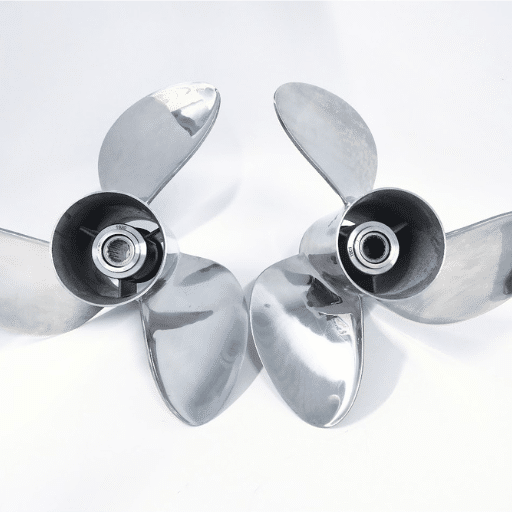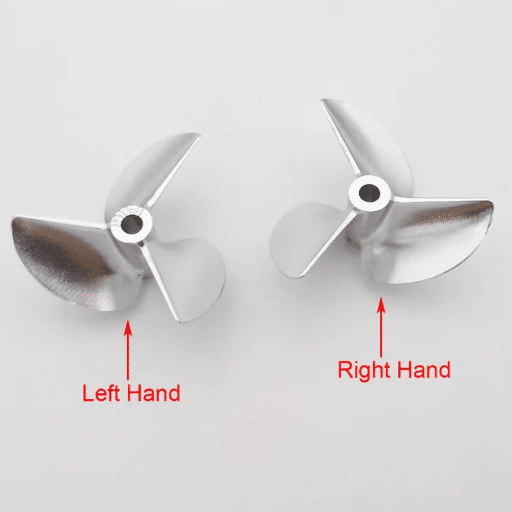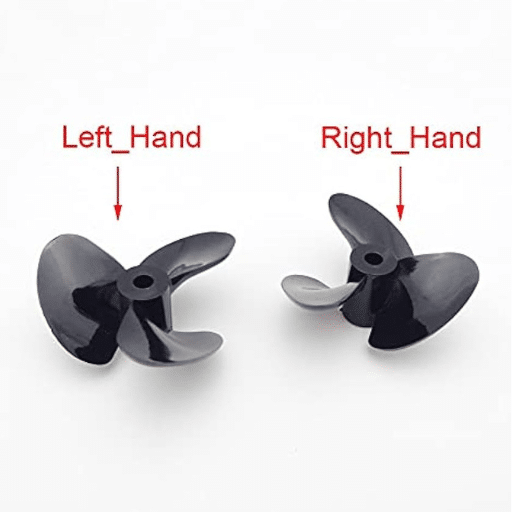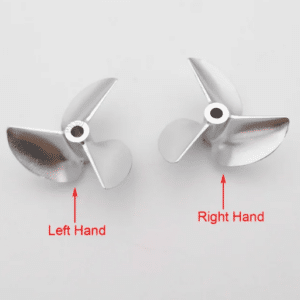As regards marine engineering and aerodynamics, the propeller dynamics understanding is essential to enhance performance and efficiency. This post discusses the differences between the left hand vs right hand propeller. The blog will describe the construction of each propeller type, their spheres of application as well as how they affect the motion of certain vehicles in water and air. In such a manner the readers will be able to see the reasons of choosing one design over the other and understand the limitations and advantages of each type in different conditions.
How to Determine a Left Hand vs Right Hand Propeller?
.png)
To know if a propeller is left hand vs right hand propeller, one has to focus on the direction of the blade’s twist that is rotated towards Wen facing the propeller, i.e. the stern for the Marine propeller or the rear of the engine in an airplane. A rotating clockwise propeller, also known as a standard rotation propeller, is a right-hand propeller. Conversely, a left-hand propeller rotates in an anti-clockwise direction. These designs influence the transfer of torque and can be perceived in the direction of blade rotation that moves air or water. Also, some engravings help to determine the direction of rotation; usually “RH” for the right hand and “LH” for the left. The knowledge of these components is very useful, especially in applying the right components to your project tasks.Related article: Left Hand vs Right Hand Propeller: Understanding the Differences
What is the Rotation Direction?
In answering how propeller rotation is going to determine performance, it is useful to deal with the practical aspects. It is most noticeable to me that when I look at the right-hand propeller from behind in free flight, it moves and is moving in the direction of the location where the engine is located, that is, clockwise. For a left-hand propeller, this direction is reversed. This knowledge is very important when selecting propellers because there are differences in how the vehicle behaves and is controlled in a marine or aviation environment. For instance, in the case of twin engines, it is possible to avoid the adverse effect of torque by using counter-rotating propellers which are better for control. Thus obtained characteristics make it possible to assure that the propeller performance will meet the requirements of the particular application for which it is meant.
How Does the View from Aft Affect Identification?
It is easy to detect the rotation of a propeller whereby it has a specific turning motion when viewed from the back side of a boat. When standing behind an engine or a vessel and looking at a right-hand propeller it appears to be rotating in a clockwise direction while the left-handed propeller will appear to be rotating in an anti-clockwise direction. This is an important viewpoint as it makes it easy to tell the type of propeller fitted at once thus eliminating any chances of incorrect fitting which would have unfavorable performance. In addition, many manufacturers apply rotational markings at the hub and this marking is visible from this angle.
What are the Characteristics of Left-Hand Propeller?

Left-hand propellers can best be identified as those that rotate counterclockwise when viewed from the back or stern of the boat , as opposed to right-hand propellers with clockwise rotation. The left-hand propeller rotation is important when certain torque must be compensated to achieve the desired maneuver of the vessel. Thrust is also directed in the required direction owing to the constructed angle of the blades of a left-hand Propeller. Left-handed propellers are commonly used in twin-engine configurations to reduce or cancel the effect of torque on controlling the twin-engine propeller set up. These props are also marked by the manufacturers with a distinctive left-hand design which ensures that the prop goes on the correct side during fitting.
Understanding Left Hand Rotation
To do a left-hand rotation, the left-hand turning axis is brought into the picture. From this position, I would like to stress a few things for my presentation. To begin with, as viewed from the vessel’s stern, left-hand propeller blades are counterclockwise, which is very applicable in balancing forces in marine applications. I have understood that such propellers find application in intermeshing bi-engine layouts to counter the torque effect, which is responsible for the deterioration of the performance of the vessel. Insights from the manufacturer’s manuals and instructions stress the need for proper orientation and fixing of left-hand propellers and provide the keys identifying markings to distinguish these propellers from the rest. Such information helps me to be in a better position to choose and use the most suitable configuration of the model of the propeller.
What is the Role of the Hub and Shaft?
In a marine system propulsion, the elements of the hub and shaft are essential elements in ensuring that proper propulsion and performance of the vessel is achieved.The shaft on the other hand transfers the power of the engine, through the gearbox, and propulsion system which powers the propeller to move and thrust the ship forward in water. Furthermore, it is important to highlight the issue of wear and tear of both parts – hub, and shaft, as a distortion of those components will lead to vibrations that reduce the performance and durability of the propulsion system.
How Does the Blade Design Affect Performance?
The blades’ geometry on the propeller has a pronounced effect on its effectiveness through a number of engineering aspects. Through the design of a ship’s blade, one can control the thrust, efficiency, and noise emission of the vessel. Central features are:
- Blade Number: The more blades there are, the smoother delivery of power and lesser vibrations are experienced but there may be an increase in drag and perhaps some reduction in efficiency.
- Blade Area Ratio: Operating at a higher ratio may restrain the likelihood of cavitation formation but this could lead to a situation where moving at higher speeds becomes unachievable because of lower efficiency.
- Blade Pitch: This is the angle at which the shock waves travel through the water in order to get cut. Higher pitch values always mean that more power is available but they also require a certain amount of engine power.
- Rake Angle: It refers to the angle of the blades which appears to have been tilted away from the central hub and affects both the lift and clearance between the hull and blades.
Taking these factors into account enables me to select a blade that matches the expected performance parameters by which the ship will be used in terms of speed and load.
What Advantages Does a Right-Hand Propeller Offer?

Depending on the design and operational environment of the vessel, a right-hand propeller that rotates clockwise when viewed from the stern has some benefits. First, because it is the normal direction of rotation, it helps neutralize the torque action of most marine engines, which simplifies installation and operational integration on the whole, resulting in more cost-effective systems. Their compatibility helps to improve engine efficiency and performance. Secondly, right-hand propellers are important in decreasing propeller walk or lateral thrust, which for some vessels, is essential for handling characteristics. Finally, the popular use of right-hand propeller has made its usage common and thus if it undergoes breakdown, replacement or repairs are much easier to come by. Nevertheless, the particular benefits may be different based on the general configuration design and use of the vessel hence, these aspects must be factored into during decision-making.
Impact of Clockwise Rotation
The clockwise rotation of a right-hand propeller when installed on a vessel influences its control as well as its efficiency. In my research, I’ve learned that most clockwise rotating propellers are more in line with the thrust and torque of engines thus increasing the overall operation and efficiency. Furthermore, a large number of vessels are built with rotation in mind, improving their steering and handling. This can reduce propeller walk, a critical consideration in any maneuver that requires a high level of precision, especially when docking in a confined area. To conclude, the clockwise rotation of a propeller fits numerous configurations for marine engines providing backwards compatibility and better performance.
Benefits of Single Engine Boats
This helps to reduce engine stress and increases fuel economy, which is very important in a single-engine setup. Also due to having a clockwise rotation, the propeller walk lateral force is reduced, which can drastically affect maneuverability and control while trying to dock a boat in close confines. Most builders have specialized hulls to match the common rotation direction of the propellers for ease of use and better control. In conclusion, single-engine boats adopt right-hand propellers to maximize performance and handling in the boats.
How Does it Pro Against Counterparts?
There are a few advantages that are presented by right-hand propellers when compared with the left hand. For example, reducing the strain on the engine which directly helps in enhancing fuel efficiency and also enhances the lifespan of the engine due to alignment with the clockwise rotation of engine torque. In the case of operability, the less percentage of propeller walk effect improves steering, which is very useful when the vessel is docking or when trying to move around in a limited working area. Particular technical parameters such as pitch and diameter are important; the explanation is that on the whole a right-hand propeller propeller gets the power from the engine more evenly, thus optimizing thrust and balance. Furthermore, these propellers often match hull shape which also improves vessel control and effectiveness.
How to Choose Between a Left-Hand and Right-Hand Propeller?

A couple of important considerations should help you in making the decision with regard to whether to use a left-hand or a right-hand propeller. First of all, it is prudent to look at the engine layout as single-engine boats generally have right-hand propellers because of the torque of the standard engine. In the case where twin engines are employed, the use of both left-handed and right-handed propellers would be preferable to avoid an imbalance of thrust and lateral load moment. The type of boat and its use is also a factor; for example, boats that need quick turns i.e. which dock or operate in a congested area, they might prefer right-hand types for ease of control. A review of the manufacturers’ guidelines on the hull configurations of boats and the engine design is also useful to improve performance and prevent wastage of resources making the decision.
Analyzing Boat and Engine Compatibility
Then I would tackle the issue of the engine configuration since it is important when determining the type of propeller to be used. As far as I understand it, single motor boats usually go well with right-hand propellers; this is common practice since it works well together with the torque of most engines and allows better thrust balancing. However, in a ship with a twin-engine system, it is commonly recommended to have one left-handed and one right-handed propeller in order to have adequate thrust while minimizing lateral forces. There is also the consideration of where the ship will be used most. If I were going in and out of a lot of docks or working in tight quarters, having a right-hand propeller might give me the precise control I require. I would also examine the manufacturers’ recommendations about the hull and engine in order to verify that the propeller chosen would provide the best forward motion and fuel economy. Such procedures guarantee that my engine and boat will achieve the best operational efficiency.
Understanding Slip and Gear Ratios
Let me begin with the slip and ratio of gears; I would first define slip as the difference between the theoretical and actual distance traveled by a boat propeller during one revolution. This slippage affects the performance and efficiency in general. The gear ratio, by contrast, indicates the output power of the engine in respect to the revolutions of the shaft of the propeller and determines both torque as well as speed. Among all resources, I would seek to reduce the slip to the minimum by choosing an appropriate pitching of the propeller to achieve the required thrust. Also important is the selection of an optimal gear ratio so that the power developed by the engine will be able to meet the speed requirements of the boat. All in all, these factors combined guarantee a perfect and efficient operation.
What is the Screw Effect on Hull?
The screw effect on the hull, otherwise known as the propeller walk, refers to an occurrence that results in the translation of the vessel on lateral space upon the rotation of the propeller. This lateral translation occurs as the downward turning blades are able to push more water than the other ones in the rotation moving upwards which leads to a sideward force. This phenomenon is greatest when a vessel is moving slowly and more, especially when docking is taking place. I would suggest that a number of technical parameters be taken into consideration in control of the situation such as appropriate diameter and pitch angle of the selected left hand vs right hand propeller, precise engine alignment, and rudder or trim tabs adjustment to achieve the desired control. These parameters are key in reducing the screw effect and improving the steering.
Can a Right Hand Propeller be Converted to a Left Hand?

The reverse of a right-hand propeller to a left-hand is not actually possible in most instances. This is because propellers are built to have a given blade angle, in this case, the left-handed, in order to produce torque at spinning. If one tries to alter the blade pitch or shape the propeller, then the propeller is bound to lose its functionality and strength. If it is needed to have such an arrangement, then a propeller that is intended for left-hand rotation can be acquired. Also, most of the time when the direction of the propeller is altered, it is necessary to make appropriate changes to the engine and drive train as well.
Challenges in Prop Conversion
As I learned, switching the rotation of a propeller entails some difficulties. To begin with, it is obvious that it is impossible to convert a right-handed propeller to the left or vice versa, by simply modifying the existing propeller. Each is precisely designed to meet certain performance requirements, hence, changing them will produce wastage or risk damage. Second, it should also be taken into account the integration of the propeller together with the existing engine and drive systems. Most often such a conversion requires extensive modifications of these systems which are quite intricate and expensive. Hence the consensus opinion of proficient resources is that such a propeller development should be avoided and instead, a propeller that will give the required rotation and be effective in propulsion without compromising the hull of the vessel.
Is it Cost-Effective to Modify a Right Hand Propeller?
At least very little economic point, changing a standard right-hand propeller to rotate to the left. Almost all come to the conclusion that the scale of work associated with such rework, as changing the pitch and shape of the propeller blades and the engine and drive systems, exceeds the potential savings of costs. Such designs usually expect that propeller pitch, diameter, and shape of the blades would be appropriately realized in correspondence with the geometric configuration of the existing part of the vessel. Of course, such radius may differ significantly as the propeller should be attached to the engine and power plants of a certain type of boat. In view of the high attestation of works and the respective risks of non-optimization or destruction, it is generally more sensible to seek out a propeller compatible with the desired rotation than to modify the propeller that is not suitable.
References
- Right Hand vs. Left Hand Propeller
- Prop Choice Right or Left Hand? help
- Propeller – Types, Construction & Efficiency
Frequently Asked Questions (FAQ)
Q: What is the difference between a right hand propeller and a left hand propeller?
A: A right hand propeller (RH prop) rotates clockwise when viewed from the rear, while a left hand propeller (LH prop) rotates counterclockwise. The choice between them depends on the boat’s engine rotation and the desired maneuverability.
Q: How can I determine whether my propeller is right or left hand?
A: To determine whether a propeller is right hand or left hand, you can look at it from the back (transom side). If it turns clockwise, it is a right hand prop; if it turns counterclockwise, it is a left hand prop.
Q: Why do boats sometimes use a right hand propeller and sometimes a left hand propeller?
A: Boats use different propellers to counteract the natural rotation of the engine and to improve handling. For twin-engine setups, one engine often uses a right hand prop and the other a left hand prop to balance thrust and reduce sideways movement.
Q: What is the role of the prop shaft in propeller rotation?
A: The prop shaft connects the engine to the propeller, transmitting power and determining the direction in which the propeller rotates, whether it is a right hand or left hand configuration.
Q: Can I use a left hand prop on a boat designed for a right hand propeller?
A: Using a left hand prop on a boat designed for a right hand propeller may not be optimal and can lead to handling issues. It’s important to match the propeller to the engine’s rotation direction.





